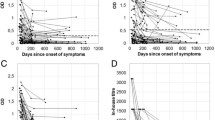Abstract
Sera from 94 healthy Finnish and 100 healthy German blood donors were studied forYersinia enterocolitica antibodies by two different techniques, enzyme immunoassay and immunoblotting, to compare the frequency ofYersinia infections in Finnish and German populations. The prevalence ofYersinia antibodies in Finland (19% and 31% by enzyme immunoassay and immunoblotting, respectively) and in Germany (33%, 43%) is relatively high and may indicate many subclinicalYersinia infections in healthy populations. Postinfectious complications, such as reactive arthritis, may follow also such subclinical infection; sensitive serological tests are important in their diagnosis.
Similar content being viewed by others
References
Hammer M, Gifhorn S, Heesemann J, Zeidler H (1995) High frequency ofYersinia antibodies in undifferentiated arthritis. Arthritis Rheum 38 [Suppl]:348
Granfors K, Jalkanen S, von Essen R et al. (1989)Yersinia antigens in synovial fluid cells from patients with reactive arthritis. N Engl J Med 320:216–221
Jacobs J, Jamaer D, Vandeven J, Wouters M, Vermylen C, Vandepitte J (1989)Yersinia enterocolitica in donor blood: a case report and review. J Clin Microbiol 27:1119–1121
Granfors K, Ogasawara M, Hill JL, Lahesmaa-Rantala R, Toivanen A, Yu DTY (1989) Analysis of IgA antibodies to lipopolysaccharide in yersinia-triggered reactive arthritis. J Infect Dis 159:1142–1147
Granfors K, Lahesmaa-Rantala R, Stáhlberg TH, Toivanen A (1989) Comparison of bacteria with and without plasmid-encoded proteins as antigens for measurement of immunoglobulin M, G, and A antibodies toYersinia enterocolitica by enzyme-linked immunosorbent assay. J Clin Microbiol 27:583–585
Heesemann J, Eggers C, Schröder J, Laufs R (1986) Serological diagnosis of yersiniosis by the immunoblot technique using plasmid-encoded antigens ofYersinia enterocolitica. In: Simon C, Wilkinson P (eds) Diagnosis of infectious diseases — new aspects. Schattauer, Stuttgart, pp 79–88
Heesemann J, Gross U, Schmidt N, Laufs R (1986) Immunochemical analysis of plasmid-encoded proteins released by enteropathogenicYersinia sp. grown in calcium-deficient media. Infect Immun 54:561–567
Heesemann J, Schröder J, Ulrich M (1988) Analysis of the classspecific immune response toYersinia enterocolitica virulenceassociated antigens in oro-gastrically infected rabbits. Microbiol Pathogen 5:437–447
Toivanen P, Koskimies S, Granfors K, Eerola E (1993) Bacterial antibodies in HLA-B27+ healthy individuals. Arthritis Rheum 36:1633–1635
Wenzel BE, Heesemann J, Wenzel KW, Scriba PC (1988) Antibodies to plasmid-encoded proteins of enteropathogenicYersinia in patients with autoimmune thyroid disease. Lancet I:56
Mäki-Ikola O, Granfors K (1992) Salmonella-triggered reactive arthritis. Lancet 339:1096–1098
Leino R (1982) Human yersiniosis. A clinical study with special reference to lymphocyte transformation in yersinia arthritis. Thesis, University of Turku, Turku, Finland
Author information
Authors and Affiliations
Rights and permissions
About this article
Cite this article
Mäki-Ikola, O., Heesemann, J., Toivanen, A. et al. High frequency ofYersinia antibodies in healthy populations in Finland and Germany. Rheumatol Int 16, 227–229 (1997). https://doi.org/10.1007/BF01375653
Received:
Accepted:
Issue Date:
DOI: https://doi.org/10.1007/BF01375653




